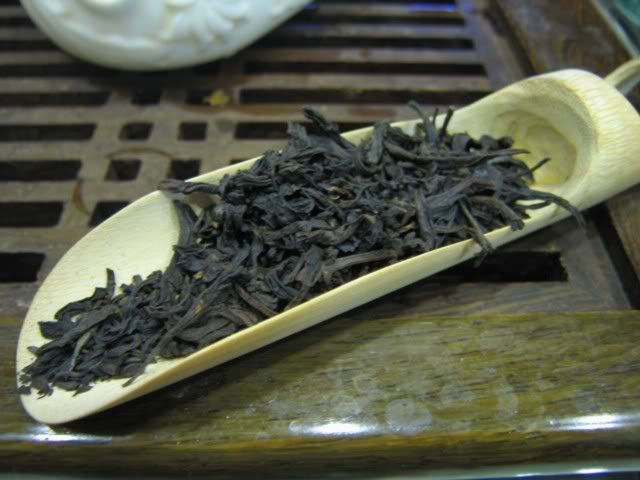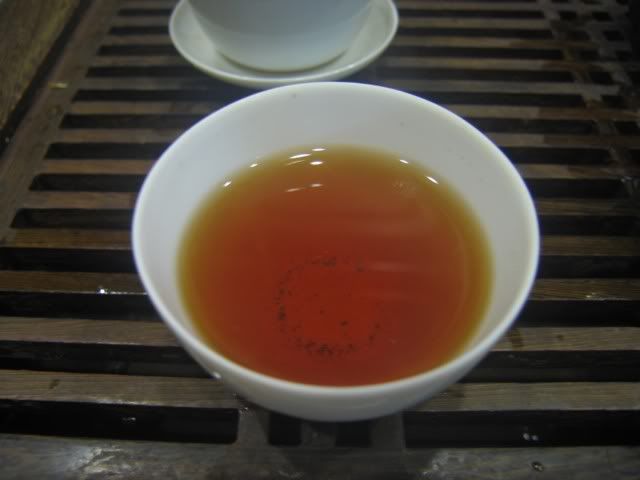Back to the lineup of aged oolongs…
This is an aged baozhong from Youji that I visited last weekend, and that I might visit again this weekend. When I asked them for aged tea, this is what they showed me. When I tried it at the store, I didn’t like it too much, because it’s a bit sour and a bit weak, but it was brewed lightly in a porcelain pot. It wasn’t the ideal setup for me, given my drinking habits, so I decided to buy some of this and try it at home. Despite the fact that one can try teas out at stores…. there’s nothing like trying a tea out at home.
You can’t tell too much from the dry leaves


The liquor tells a little more… although I actually forgot to take a picture before a few infusions went by, so the colour lightened up a bit.
The tea actually is quite similar to the alleged 60s baozhong I had a little while ago. The tea opens with a bit of sourness, and then delivers that aged taste…. etc
There’s only one obvious difference — the price.
The tea I tried last week costs something along the lines of $270/600g. This one today costs about $55/600g.
Yeah, 1/5.
Here’s the deal with aged oolong prices — it’s all over the place. Every store has some of it. They will tell you it’s aged, it’s been in their store for years, etc etc. Sometimes they can tell you where it’s from, other times they can’t. They will show you the tea, you can try it, and their taste is also all over the place — some taste like newly roasted tea, others taste like slightly aged green oolong, more taste like real aged oolong…. and the level of agedness has almost nothing to do with the price. I think one difficulty is simply because these things are not, and cannot, be labeled — a 5kg canister of tea is a 5kg canister of tea. Unless they come in those competition or whatever boxes that can be dated, it’s just loose leaf tea, and whether it’s 3, 5, 10, 50 years old… is up to the seller to claim and the buyer to decide.
Which, in some ways, is how things should be. You can decide if you like the tea or not on its own merits — not based on a wrapper or a reputation or somebody else’s opinion. After all, tea is for drinking. Do I (or will I) enjoy this tea? Is it worth it? Those are the two questions that I try to answer whenever I try out a new tea. If the answer to either of these is a “no” or even a “maybe”, I won’t bother.
I think it’s a shame that aged oolongs don’t get much coverage outside of Taiwan, let alone in the West. They’re every bit as good as old puerh, I think, but often for far less money (an aged puerh would be considered cheap even at the price of the more expensive baozhong here). Their problems are 1) lack of large volumes, 2) relative difficulty in storage, 3) difficulty in authentication, and thus 4) lack of consistency, again due to storage and authentication. There isn’t a lot of money to be made in these things, if at all. Like today… I know that I shouldn’t get the expensive one, but the cheap ones might be a good buy, and I might go and get some more to stock up for future consumption. At $270/600g, it’s not really an everyday tea (although still not too pricey, I suppose). At $55/600g, I can do whatever I like with it and won’t feel any guilt. The choice is pretty simple.

4 responses so far ↓
wyardley // October 26, 2007 at 3:10 pm |
I think tea shop owners are hip to foreigners liking the flavors of aged tea – at least I got a lot of pitches for aged tea when I was in China recently. Of course that may have just been because they’re (relatively) expensive. I bought some aged stuff that’s pretty good (IMO), though expensive, and some cheaper stuff that honestly, I think is maybe just roasted – it is supposedly aged 10 years, but doesn’t have any of the characteristics I associate with even 10 years of age. But I’m waiting to see if it mellows out after sitting for a little.
I think aged oolongs are already seeing a slight upswing in popularity everywhere (maybe because of the crazy prices of pu’erh, maybe not), and I think that will probably continue.
My understanding (correct me if I’m wrong) is that a lot of the older aged oolongs available now were originaly saved mostly for medicinal purposes. So it’s possible that not as much attention went into keeping the storage conditions ideal as it might now.
Imen has some older Dan Congs coming in – I’ll send some along with your samples if they come in time.
MarshalN // October 26, 2007 at 11:17 pm |
I think for the most part they’re teas that weren’t sold in the current year and just left behind — i.e. remainders!
I’d be pretty suspicious of aged teas in mainland China. I’ve had a few…. none taste aged.
behhl // October 27, 2007 at 10:10 pm |
That $55/600g is a really good price. … maybe the hordes are coming or not, but without some organisation like Wushing getting behind it I doubt it will really take off. They need a story to sell – the fact that most old oolongs are probably left overs from unsold stock etc, and not pre-packed away with brand names like the 30s vintage puerh probably doesn’t help the mystique which helped puerh take off.
I kind of think that how Puerh Teapot mag got behind the puerh movement really gave it the push it needed, perhaps a fluke of luck with the environment in China changing as well into a more conducive environment.
MarshalN // October 28, 2007 at 3:02 am |
Yeah, it’s a combination of the takeoff of Chinese economy, publicity, etc
Aged oolongs are hard to do the same for, mostly because there aren’t tonnes of this stuff lying around in recognizable way — it’s hard to convince somebody that this stuff really is 20 or 30 years sometimes.